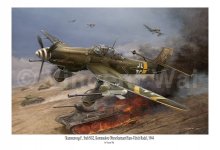An interesting Sherman tidbit is that the US 76mm gun was potentially as potent as the 17 pounder...the tubes had very similar ballistic profiles. What differed was the ammunition. The US wanted to use underpowered AP ammo to preserve tube life. The Brits (17pdr) & Germans (75L70 gun) chose higher powered ammo & preferred to win battles. The Americans hoped to have a fancy resolution to this problem in the form of the high-tech HVAP ammo, but was late to the party. As proof of concept, 76mm HVAP made short work of T-34/85s in Korea. The Sherman 76mm with green crews did extraordinarily well against veteran North Korean T-34s. The Sherman must have been a really fantastic tank design, because even as late as the 1960s, many Israeli tank veterans preferred their Super Shemans to Centurions
p.s. very nice picture composition there



